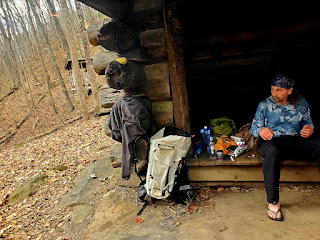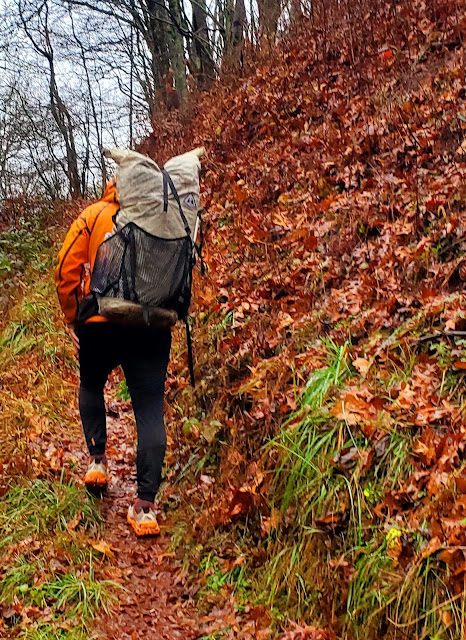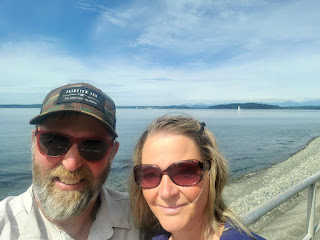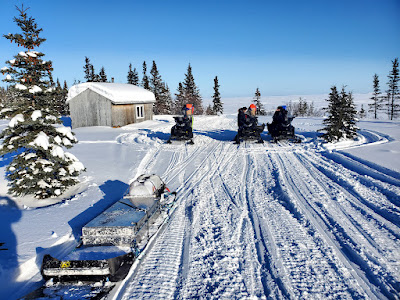The First 200 Miles
-A section hike of the Appalachian trail
“The Journey of a thousand miles begins with a single step”-Laozi
A lone red maple leaf stood-out on top of a sea of brown ones. The trail was filled to its shoulders with big crispy leaves as if it had been done on purpose. It was soft. Our feet made satisfying crunches and smushing sounds as we put down our first steps on a very long and storied trail.
 |
| Our start at Springer Mountain. |
A Side Thought
It was a side thought really. Tamra and I had been planning a vacation around my November birthday. Our plan included visiting New Orleans, Memphis, and then Nashville. Afterwards she had to get home for work but I’m retired. “How could I extend my stay and go hiking?”, I thought. It didn’t take too long to realize how close I would be to the world famous Appalachian trail.
“I think I want to do some hiking on the A.T.” I told her. After explaining my idea, she was excited for me.
The older I get the harder time I have dealing with the darkness. Besides in November there typically isn’t enough snow to play around with (...skiing, snowmachining, ect), and the rivers aren’t safe enough for travel yet, so I can’t get to the cabin.
I mentioned it to my buddy Mark and he immediately got excited. “Who are you going with?” he asked.
“By myself unless you want to join me.” I said.
“Wow, that sounds great, I think I do”. And so after looking at his work schedule and confirming with his wife he committed, setting into motion the planning of our great trip.
No stranger to adventure, Mark is an accomplished Alaskan outdoorsman and along with his equally adventurous wife Aubrey invested in a freeze-dryer. As it turns out freeze drying your own meals for lightweight backpacking is a game changer. When you have to carry all of your food on your back, every ounce matters. Additionally the commercially available freeze dried meals are super expensive and packed with additional preservatives that don’t set well in my gut over days in-a-row of consumption. |
Mark taking five in the sunshine.
It was 16 below on this day at home . |
Aubrey hooked me up with several aluminum trays that resembled cookie sheets. Over the course of the next several days I filled them with home cooked meals loaded with sauteed veggies and moose sausage. I made spaghetti, macaroni surprise, red beans and rice, and curried caribou with coconut milk and rice. Aubrey put them in the magic machine and when I got them back they had lost 80% of their original weight, yet retained over 90% of their nutrition. Simply add boiling water, stir, and enjoy!
So it was set. After Nashville, Tamra would fly home and I would fly 30 minutes South to Atlanta Georgia where I would meet up with Mark. We had arranged a shuttle to Springer Mountain, the Southern terminus of the Appalachian Trail.
“Pile in guys; Make yourselves at home”, He said. “I’m Ron”. I had booked our shuttle with Ron’s Appalachian Trail Shuttle over two months ago and he was nice enough to chat with me on the phone a couple of times about trail conditions. Hurricane Helene had passed through the Southern U.S. and parts of the trail had been affected.
Ron was quite the chatterbox and filled the hour long ride to Springer with trail tips and advice. As our hike progressed over the course of several weeks we would occasionally recall one of Ron’s tidbits of advice. “Here you are...Springer Mountain”. He said. “ Oh, and here’s your first trail magic.” He handed us a tootsie pop and wished us luck.
The Trail
As far as hiking trails go there is no doubt that the Appalachian trail is nothing short of superb; It was among the best I’ve seen. The well thought-out trail was graceful, gently-sloped, and well marked..
Much of the was covered with leaves belonging to unfamiliar trees. I would find out later that our towering friends included five varieties of giant Oak, three varieties of Hickory, Red Maple, White Pine and White Ash. The only tree I recognized was the occasional Birch, but those were few-and-far-between. There was minimal underbrush and often you could see through the forest for long distances. |
Behold the most photographed tree on the AT.
It was near the Georgia/ North Carolina border. |
Since Mark was from Minnesota originally, at times I could tell he was feeling nostalgic with the sights and smells of the forest, some of which were common to the woods of his childhood. Often Mark’s comments would turn towards whitetail deer hunting. In fact, it was easy to imagine deer passing through the wooded mountains as we hiked. Finally after ten days of hiking, we spotted a doe and fawn as they slowly traversed around a steep ridge out of sight. “Awesome”, said Mark.
Another oddity for this sheltered Alaska boy was the presence of acorns. They were littered along the trail and could be heard dropping to the ground at night. Maybe that’s why we were seeing so many gray squirrels the size of nerf footballs.
Along with the two whitetail deer, we saw three black bears, and several groups of rough grouse. We were hoping to see wild boar too but they were elusive although we did see plenty of their sign as they are notorious for rooting up the ground in search of nuts, roots, and other goodies.
Elk had recently been reintroduced to the Great Smoky National Park and we were hopeful to see them. Unfortunately our three days in the park were socked-in with fog and the views were limited.
Shelters
Each night we would end our day at one of the AT’s many three-sided shelters. Each shelter was similar in size but differed in construction methods and features. Several of the shelters were assembled with full-scribed log joinery that were built in the 1930’s. Several others were made of stone, and we stayed in one that was a true timber frame with no metal fasteners. Each shelter site had a privy, campfire ring, multiple campsites, and a source of water. |
| Hawk Mountain Shelter |
We only slept in two of the shelters because the field mice were on-point. One such time I was awakened to the sounds of Mark scurrying around in the darkness to set up the tent after starting out initially in the shelter. I found out the next morning that a mouse had run across his face; We slept in the tent every night after that.
In the first half of the trip our mileage varied from 8 to 18 miles per day. After day ten, we realized that we’d better slow-our-roll because we had arranged to fly out of Knoxville. We made this decision early in our planning because of post-Helene trail reports. These reports turned out to be greatly exaggerated and we could have planned to go further but we were happy with our itinerary. “Hey there’s a hostel coming up in Hiawassee”, I discovered while pursuing the guidebook.
 |
|
 |
The Green Dragon had this picture on the wall.
We stayed at five of these. |
 |
Selfie from The Fontana Hilton the cushiest of all of the shelters.
We spotted all three black bears from here; They were beach combing
along the shores of the Fontana Reservoir in the distance beyond. |
Hostels
What better way to slow-our-roll than to check out a hostel or two along the way? Mark and I missed the hostel-thing in our twenties and were excited to check it out.
Our first hostel was The Green Dragon in Hiawassee Georgia. Themed after Frodo Baggins favorite inn in Tolkien’s “Hobbit”, it was nothing short of fantastic. Several Hobbit quotes could be found written in recognizable Hobbit calligraphy on the walls. “No admittance except on party business” was posted on a laundry closet. It was a very well run and clean hostel that anticipated the wants- and-needs of the weary hiker.
Forty dollars at the Green Dragon gets you a little more than a night's stay. Included is shuttle pick-up and drop off to the hostel (10 miles each way), bunk bed with fresh linens and memory foam mattress with privacy curtain, hot shower with soap, shampoo and towel, and a hot breakfast the next morning. Also they shuttle everyone to downtown Hiawassee where you can resupply at a full grocery store. There is also a post office, outfitter (think REI), and a local brewery. Did I mention that they also do your laundry for you? They have a neatly organized closet of loaner clothes organized by size. Mark and I picked out some great outfits! This allowed us to have all of our clothes washed; We would be fresh-as-daisies when we hit the trail! Later that night I found all of my clothes neatly folded and stacked on my bunk. Forty bucks; We were blown away! The two other hostels we would stay at were very similar in service and value but the Green Dragon stood out as our favorite. |
| Mark looking good in his loaner clothes! |
 |
Discarded hiker's shoes at the Grove hostel.
Each pair represents someone who ended their
hike here. |
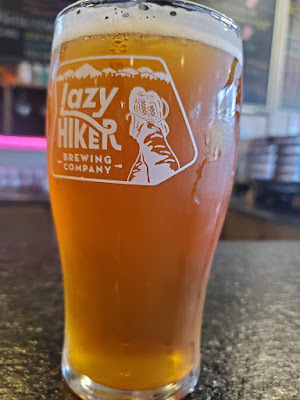 |
| The Lazy Hiker brewery was a short walk from the Grove hostel. |
General thoughts
In the end it was a good block of time to walk all day everyday through the mountains with a good friend. With no projects to complete or deadlines to meet, or chores to do, the day’s activities were always the same: wake up, make coffee, slowly pack up and start walking.
Unlike hiking in Alaska, the AT is pretty forgiving. It’s hard to get lost, there are resupply points along the way including outfitters and post offices. Other hikers are met everyday, some of which are quick to offer unsolicited advice as a matter of course. Mark and I found this humorous but in-truth everyone we met was very nice and interesting.
Often we would talk, run ideas by each other, make jokes, or comment on the scenery as the sights revealed themselves before us. But it was also a great time for solitude, self reflection, and daydreaming. I appreciated the time to organize my thoughts, priorities and plan for all of the amazing things coming up in my life upon returning to Alaska.
Leaving the trail
“Dude, maybe you should break-off your stach-cycle” He said. We chuckled as I snapped off a 2 inch icicle from my upper lip. We were trying to hitch a ride into Gatlinburg after leaving the trail at Newfound Gap. I left the rest of my beard ice intact for good measure. We were a day earlier than we expected but it was getting pretty cold with snow and freezing temperatures in the higher elevations. One night I mistakenly left out a full bottle of water and it froze solid.
The line of cars slowly snaking through the windy road was continual. It was the day after Thanksgiving in the most visited national park in the U.S. and the highway was absolutely packed.
After only a few minutes a large black escalade pulled over. It was a family of four returning home after elk viewing at a popular spot in the Smokies. “Thank you so much for the ride”, Mark said.
“No problem”, said the man who was driving. “I had to pull over, he looked so cold with all that ice on his face”. I chuckled at myself as I worked at pulling off the remaining chunks of ice from my beard.
The fifteen miles into Gatlinburg took us an hour and a half with bumper-to-bumper traffic. We chatted with the nice couple as we slowly made our way down out of the mountains.
Tired, cold, and hungry, our 19 mile hiking day turned out to be our longest. We had such a wonderful hike and it was a little hard to believe that it was over. “We did it”, said Mark as he came-in for a hug. We had found a motel room and the relief that all discomfort and struggle was in the past was a happy thought indeed.
With nothing more to accomplish, our thoughts turned towards cheeseburgers and home. |
| Bad hair days were "standard operating procedure" |









